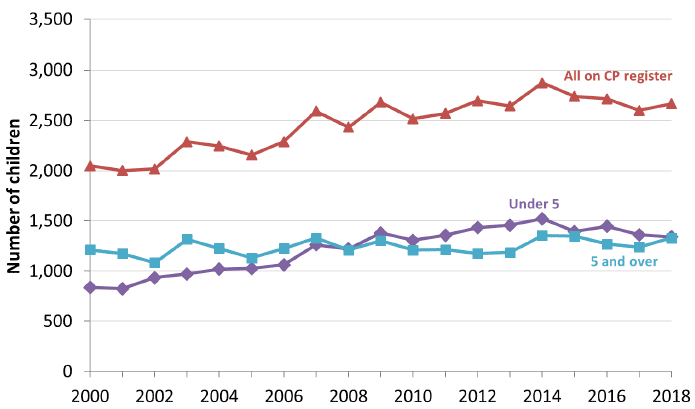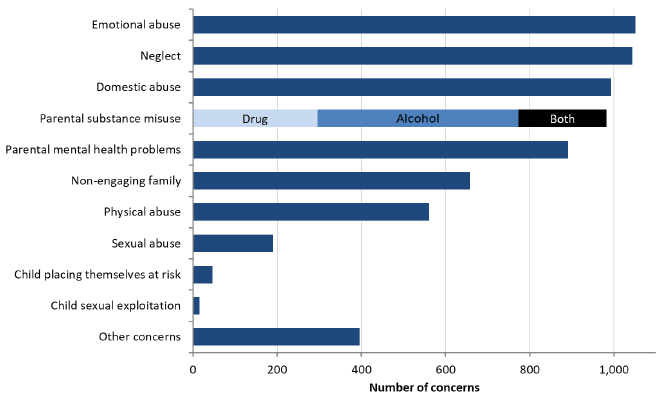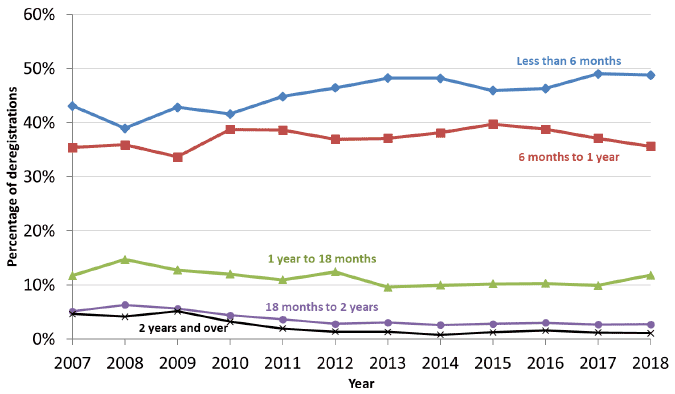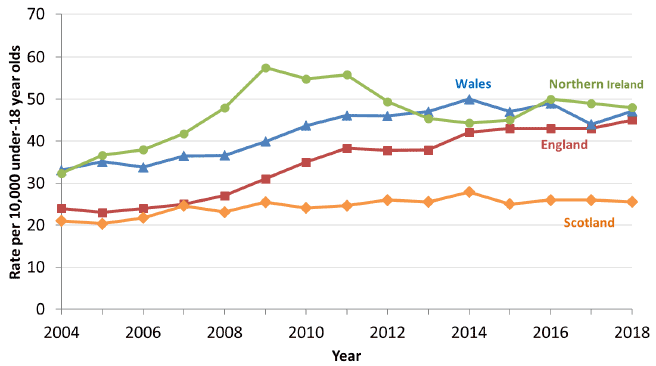Children's social work statistics 2017-2018
The latest data on children and young people looked after, on the child protection register and in secure care.
Child Protection

Number of children on the child protection register increased slightly in 2018, but remains lower than the recent peak recorded in 2014

Around half of children were on the child protection register for less than 6 months

Causes for concern relating to emotional abuse and neglect were the most prevalent
This section presents data on children on the child protection register from 1 August 2017 to 31 July 2018. This will be referred to as 2018 for ease of reporting (with 2016-17 referred to as 2017 etc.). Child protection means protecting a child from abuse or neglect. This can either be in cases where abuse or neglect has taken place, or in cases where a likelihood of significant harm or neglect has been identified. The risk of harm or neglect is considered at a Child Protection Case Conference. Where a child is believed to be at risk of significant harm, their name will be added to the child protection register (a child protection registration).
2017-18 was the sixth year that child protection data has been collected entirely at individual level. As the series has lengthened, more in-depth validation of the data has been possible, which gives a high level of confidence in its accuracy. Some of the 2017 figures in this publication have been revised as part of the 2018 validation process.
Children on the child protection register
The number of children on the child protection register increased from 2,600 in 2017 to an estimated 2,668 in 2018 (a 3% increase). Chart 3 shows that the number of children on the child protection register fluctuated regularly, and there was a general upwards trend until 2014. However, in the last four years there has been an overall decrease, although there was a slight increase over the latest year.
Following updated information from local authorities, the number of children on the register at 31 July 2017 has been amended from 2,631 to 2,600. It should be noted that relatively large year-on-year changes are experienced in a number of local authorities (see Table 2.4 for local authority level breakdowns). The number of children on the register in 2018 will also be revised in next year's publication. It should be noted that this revision is usually in a downwards direction, therefore the increase in the number on the register may be smaller than the 3% reported once the 2018 figure is revised.
Chart 3: Number of children on the child protection register at 31 July, by age, 2000-2018(1)

(1) Data for 2018 is estimated by using 2017 figures for Glasgow City and 2018 figures for all other local authorities.
In 2018, half of children on the child protection register were aged under five and half were over 5. Since 2008 there have been more children aged under five than over five on the child protection register, with the gap narrowing in 2018 when there were an estimated 1,340 children aged under 5 and 1,328 aged 5 and over on the child protection register.
There is no strong gender pattern among children on the child protection register - 49% were boys, 47% were girls and the remaining 4% were unborn children (Table 2.1). Because of a change in how unborn children were recorded by local authorities in 2010, figures for unborn children are only comparable from 2011 onwards.
Table 2.1: Number of children on the child protection register by gender (1,4)
| Gender | Number | Percentage | ||||
|---|---|---|---|---|---|---|
| 2008 | 2017 | 2018 | 2008 | 2017 | 2018 | |
| Boys | 1,193 | 1,245 | 1,277 | 49% | 48% | 48% |
| Girls | 1,218 | 1,306 | 1,330 | 50% | 50% | 50% |
| Unborns(2) | 22 | 49 | 61 | 1% | 2% | 2% |
| Unknown | 1 | 0 | 0 | 0% | 0% | 0% |
| All children | 2,433 | 2,600 | 2,668 | 100% | 100% | 100% |
(1) Figures for 2017-18 are provisional and may be revised in 2018-19. Figures for 2016-17 have been revised for this publication.
(2) The rate shown in this table excludes unborn children as their gender is unknown. Unborn children include both unborn children with a known gender and those with an unknown gender. Those with a known gender are not included in the boys or girls categories in this table.
(3) Source: National Records of Scotland, Projected Population of Scotland, 2016-based, 2018 projection for 0-15 year olds.
(4) Data for 2018 is estimated by using 2017 figures for Glasgow City and 2018 figures for all other local authorities.
At child protection case conferences, multiple concerns can be recorded (rather than just the main category of concern). This means that the total number of concerns is larger than the total number of registrations. For the estimated 2,668 children on the child protection register at 31 July 2018, there were 6,830 concerns at the case conferences at which they were registered - an average of 2.6 concerns per conference. Chart 4 shows the most common concerns identified were emotional abuse and neglect, with 1,051 and 1,044 concerns identified respectively. The next most common concerns were domestic abuse (993 concerns identified) and parental substance misuse (983 concerns identified). The parental substance misuse category is further broken down by the type of substance misused. Alcohol misuse only was identified as a concern in 477 conferences, drug misuse only in 296 conferences and both in 210 conferences. Data is shown in full in additional table AT4.3.
Chart 4: Concerns identified at the case conferences of children who were on the child protection register, 2018(1)

(1) Data is estimated using 2017 figures for Glasgow City and 2018 figures for all other local authorities.
Child protection registrations and deregistrations
The number of registrations to the child protection register increased by 1% between 2017 and 2018. The proportion of children registered who had never been registered before fell to an estimated 82% in 2018, down from 83% in 2017 (Table 2.2). The remaining 18% of registrations on the child protection register were for children who had been registered previously. The largest group of these children are those that had been previously registered at least 2 years ago, with this group making up 10% of all registrations in 2018.
Table 2.2: Number of registrations following an initial, pre-birth or transfer-in case conference by length of time since previous deregistration(1)
| Number | Percentage | |||||
|---|---|---|---|---|---|---|
| Time since last deregistration | 2008 | 2017 | 2018 | 2008 | 2017 | 2018 |
| Never been registered before | 2,355 | 3,552 | 3,564 | 84% | 83% | 82% |
| Registered before but time unknown | 5 | 0 | 0 | 0% | 0% | 0% |
| Less than 6 months | 95 | 123 | 86 | 2% | 2% | 2% |
| 6 months - < 1 year | 68 | 97 | 108 | 2% | 2% | 2% |
| 1 year - < 18 months | 48 | 58 | 71 | 2% | 2% | 2% |
| 18 months - < 2 years | 53 | 70 | 58 | 1% | 1% | 1% |
| 2 years or more | 181 | 363 | 433 | 10% | 10% | 10% |
| Not known if been registered before | 9 | 30 | 7 | 0% | 0% | 0% |
| Total | 2,814 | 4,293 | 4,327 | 100% | 100% | 100% |
(1) Data for 2018 is estimated by using 2017 figures for Glasgow City and 2018 figures for all other local authorities.
Table 2.3 shows the numbers of deregistrations from the child protection register. There were an estimated 4,365 deregistrations from the child protection register in the year to 31 July 2018, a small decrease from the 4,402 recorded in 2017. The most common reason for deregistration in 2018 was an improved home situation, recorded in 55% of cases.
Table 2.3: Length of time registered and reason for deregistration from the child protection register(1)
| 2008 | 2017 | 2018 | 2008 | 2017 | 2018 | |
|---|---|---|---|---|---|---|
| Length of time registered | ||||||
| Less than 6 months | 1,245 | 2,157 | 2,128 | 39% | 49% | 49% |
| 6 months to under 1 year | 1,148 | 1,633 | 1,555 | 36% | 37% | 36% |
| 1 year to under 18 months | 470 | 437 | 515 | 15% | 10% | 12% |
| 18 months to under 2 years | 202 | 119 | 119 | 6% | 3% | 3% |
| 2 years or more | 132 | 53 | 47 | 4% | 1% | 1% |
| No date of registration information | 0 | 3 | 1 | 0% | 0% | 0% |
| Reason for de-registration | ||||||
| Child taken into care & risk reduced | 411 | 600 | 531 | 13% | 14% | 12% |
| Child with other carers | 218 | 281 | 327 | 7% | 6% | 7% |
| Child died | 4 | 10 | 10 | 0% | 0% | 0% |
| Removal of perpetrator | 112 | 153 | 153 | 4% | 3% | 4% |
| Improved home situation | 830 | 2,367 | 2,419 | 26% | 54% | 55% |
| Child automatically de-registered because of age | 12 | 7 | 8 | 0% | 0% | 0% |
| Child moved away - no continued risk | 24 | 31 | 25 | 1% | 1% | 1% |
| Other reason | 1,586 | 953 | 892 | 50% | 22% | 20% |
| Reason not known | 0 | 0 | 0 | 0% | 0% | 0% |
| Total | 3,197 | 4,402 | 4,365 | 100% | 100% | 100% |
(1) Data for 2018 is estimated by using 2017 figures for Glasgow City and 2018 figures for all other local authorities.
Chart 5 shows that since 2015, the percentage of deregistrations of children who spent 6 months to under 1 year on the child protection register has decreased each year to the current figure of 36% of deregistrations. There has been a corresponding increase over this period in the proportion of deregistrations for children who spent less than 6 months on the child protection register.
Chart 5: Percentage of deregistrations by length of time on the child protection register, 2007-2018(1)

(1) Data for 2018 is estimated by using 2017 figures for Glasgow City and 2018 figures for all other local authorities.
Child Protection Register Geographical Comparisons
Within Scotland
Table 2.4 shows the number and rate of children under 16 who were on the child protection register in Scotland in 2018 by local authority. The rate varied from 0.5 per 1,000 children in East Renfrewshire to 6.7 per 1,000 children in North Ayrshire.
There is a lot of variability from year to year in the numbers of children on the child protection register at a local authority level due to the small numbers of children involved in each local authority. In many cases, there are no obvious reasons for changes, although in some areas, sibling groups entering and leaving the system has led to fluctuating numbers.
Table 2.4: Number of children on the child protection register and rate per 1,000 population aged 0-15 by local authority(1,2)
| 2017 | 2018 | |||
|---|---|---|---|---|
| Local authority | Number on Register | Rate(3,4) | Number on Register | Rate(3,4) |
| Aberdeen City | 80 | 2.3 | 68 | 1.9 |
| Aberdeenshire | 77 | 1.6 | 77 | 1.5 |
| Angus | 51 | 2.6 | 64 | 3.3 |
| Argyll & Bute | 31 | 2.4 | 31 | 2.4 |
| City of Edinburgh | 235 | 3.0 | 190 | 2.4 |
| Clackmannanshire | 26 | 2.9 | 36 | 4.0 |
| Dumfries & Galloway | 78 | 3.3 | 94 | 4.0 |
| Dundee City | 69 | 2.9 | 73 | 3.0 |
| East Ayrshire | 96 | 4.5 | 127 | 5.9 |
| East Dunbartonshire | 42 | 2.2 | 57 | 3.0 |
| East Lothian | 45 | 2.4 | 36 | 1.9 |
| East Renfrewshire | 20 | 1.1 | 9 | 0.5 |
| Falkirk | 80 | 2.8 | 88 | 3.1 |
| Fife | 172 | 2.7 | 176 | 2.7 |
| Glasgow City(5) | 405 | 4.1 | - | - |
| Highland | 102 | 2.6 | 83 | 2.1 |
| Inverclyde | 33 | 2.6 | 31 | 2.4 |
| Midlothian | 64 | 3.7 | 45 | 2.6 |
| Moray | 79 | 4.8 | 62 | 3.7 |
| Na h-Eileanan Siar | * | * | * | * |
| North Ayrshire | 60 | 2.6 | 155 | 6.7 |
| North Lanarkshire | 131 | 2.1 | 95 | 1.5 |
| Orkney Islands | * | * | * | * |
| Perth & Kinross | 81 | 3.3 | 76 | 3.1 |
| Renfrewshire | 107 | 3.6 | 103 | 3.4 |
| Scottish Borders | 39 | 2.0 | 50 | 2.6 |
| Shetland Islands | * | * | 8 | 1.9 |
| South Ayrshire | 60 | 3.4 | 44 | 2.5 |
| South Lanarkshire | 140 | 2.5 | 184 | 3.3 |
| Stirling | 47 | 3.0 | 56 | 3.6 |
| West Dunbartonshire | 71 | 4.5 | 54 | 3.4 |
| West Lothian | 70 | 2.0 | 82 | 2.3 |
(1) Figures for 2017-18 are provisional and may be revised in 2018-19.
(2) Cells containing * represent numbers that are suppressed to maintain confidentiality.
(3) Per 1,000 population aged 0-15. Source: National Records of Scotland, 2017 mid-year population estimates and population projections for 2018
(4) The rate shown in this table includes unborn children who are on the register
(5) Data for Glasgow City was not provided in 2018.
Cross-UK child protection comparisons
Child protection systems across the United Kingdom vary but are generally comparable. Scotland's collection year runs from 1 August to 31 July, so end‑year figures are typically reported at 31 July in this publication, while the collection year in England, Wales and Northern Ireland runs from 1 April to 31 March (so end-year figures are at 31 March). However, in Chart 6 we report the Scotland figures at the 31st March to allow comparison with the other countries.
The proportion of children on the child protection register has been broadly stable in Scotland over the last decade and this proportion is notably lower compared to the rest of the UK. Scotland did not experience the large increases in children on the register in 2007-2011 as seen in the rest of the UK.
Chart 6: Cross-UK comparison of rate of children on the child protection register per 10,000 under 18s, 2004-2018(1)

(1) Data for Scotland for 2018 is estimated by using 2017 figures for Glasgow City and 2018 figures for all other local authorities.
There are links to the cross-UK data underlying Chart 6 in Background Note 1.8 and more information on the comparability of child protection data across the UK here: http://www.gov.scot/Topics/Statistics/Browse/Children/socialservicestats
Additional tables on child protection are available at: http://www.gov.scot/Topics/Statistics/Browse/Children/PubChildrenSocialWork
Contact
There is a problem
Thanks for your feedback